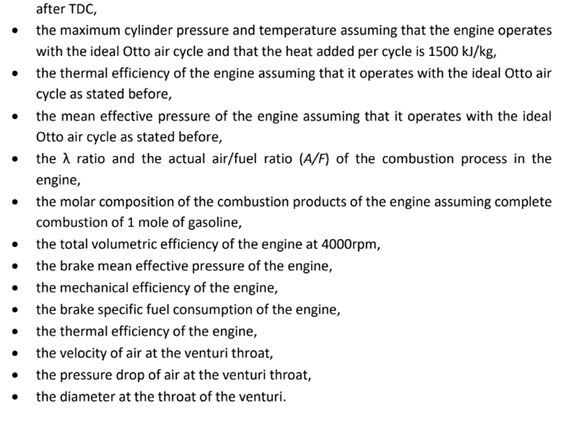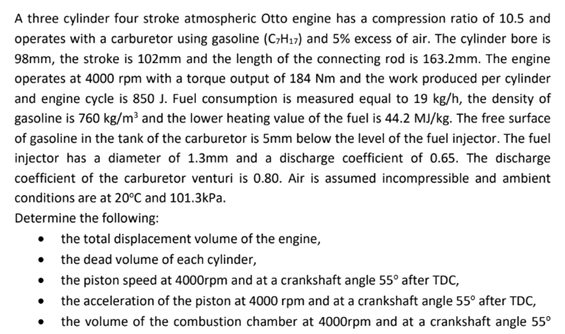after TDC, the maximum cylinder pressure and temperature assuming that the engine operates with the ideal Otto air cycle and that the heat added per cycle is 1500 kJ/kg, ⚫ the thermal efficiency of the engine assuming that it operates with the ideal Otto air cycle as stated before, ⚫ the mean effective pressure of the engine assuming that it operates with the ideal Otto air cycle as stated before, ⚫ the ratio and the actual air/fuel ratio (A/F) of the combustion process in the engine, ⚫ the molar composition of the combustion products of the engine assuming complete combustion of 1 mole of gasoline, ⚫ the total volumetric efficiency of the engine at 4000rpm, ⚫the brake mean effective pressure of the engine, ⚫ the mechanical efficiency of the engine, the brake specific fuel consumption of the engine, ⚫ the thermal efficiency of the engine, ⚫the velocity of air at the venturi throat, ⚫the pressure drop of air at the venturi throat, the diameter at the throat of the venturi. A three cylinder four stroke atmospheric Otto engine has a compression ratio of 10.5 and operates with a carburetor using gasoline (C7H17) and 5% excess of air. The cylinder bore is 98mm, the stroke is 102mm and the length of the connecting rod is 163.2mm. The engine operates at 4000 rpm with a torque output of 184 Nm and the work produced per cylinder and engine cycle is 850 J. Fuel consumption is measured equal to 19 kg/h, the density of gasoline is 760 kg/m³ and the lower heating value of the fuel is 44.2 MJ/kg. The free surface of gasoline in the tank of the carburetor is 5mm below the level of the fuel injector. The fuel injector has a diameter of 1.3mm and a discharge coefficient of 0.65. The discharge coefficient of the carburetor venturi is 0.80. Air is assumed incompressible and ambient conditions are at 20°C and 101.3kPa. Determine the following: ⚫ the total displacement volume of the engine, ⚫ the dead volume of each cylinder, ⚫ the piston speed at 4000rpm and at a crankshaft angle 55° after TDC, ⚫ the acceleration of the piston at 4000 rpm and at a crankshaft angle 55° after TDC, ⚫ the volume of the combustion chamber at 4000rpm and at a crankshaft angle 55°
after TDC, the maximum cylinder pressure and temperature assuming that the engine operates with the ideal Otto air cycle and that the heat added per cycle is 1500 kJ/kg, ⚫ the thermal efficiency of the engine assuming that it operates with the ideal Otto air cycle as stated before, ⚫ the mean effective pressure of the engine assuming that it operates with the ideal Otto air cycle as stated before, ⚫ the ratio and the actual air/fuel ratio (A/F) of the combustion process in the engine, ⚫ the molar composition of the combustion products of the engine assuming complete combustion of 1 mole of gasoline, ⚫ the total volumetric efficiency of the engine at 4000rpm, ⚫the brake mean effective pressure of the engine, ⚫ the mechanical efficiency of the engine, the brake specific fuel consumption of the engine, ⚫ the thermal efficiency of the engine, ⚫the velocity of air at the venturi throat, ⚫the pressure drop of air at the venturi throat, the diameter at the throat of the venturi. A three cylinder four stroke atmospheric Otto engine has a compression ratio of 10.5 and operates with a carburetor using gasoline (C7H17) and 5% excess of air. The cylinder bore is 98mm, the stroke is 102mm and the length of the connecting rod is 163.2mm. The engine operates at 4000 rpm with a torque output of 184 Nm and the work produced per cylinder and engine cycle is 850 J. Fuel consumption is measured equal to 19 kg/h, the density of gasoline is 760 kg/m³ and the lower heating value of the fuel is 44.2 MJ/kg. The free surface of gasoline in the tank of the carburetor is 5mm below the level of the fuel injector. The fuel injector has a diameter of 1.3mm and a discharge coefficient of 0.65. The discharge coefficient of the carburetor venturi is 0.80. Air is assumed incompressible and ambient conditions are at 20°C and 101.3kPa. Determine the following: ⚫ the total displacement volume of the engine, ⚫ the dead volume of each cylinder, ⚫ the piston speed at 4000rpm and at a crankshaft angle 55° after TDC, ⚫ the acceleration of the piston at 4000 rpm and at a crankshaft angle 55° after TDC, ⚫ the volume of the combustion chamber at 4000rpm and at a crankshaft angle 55°
Elements Of Electromagnetics
7th Edition
ISBN:9780190698614
Author:Sadiku, Matthew N. O.
Publisher:Sadiku, Matthew N. O.
ChapterMA: Math Assessment
Section: Chapter Questions
Problem 1.1MA
Related questions
Question
The questions are in the images.

Transcribed Image Text:after TDC,
the maximum cylinder pressure and temperature assuming that the engine operates
with the ideal Otto air cycle and that the heat added per cycle is 1500 kJ/kg,
⚫ the thermal efficiency of the engine assuming that it operates with the ideal Otto air
cycle as stated before,
⚫ the mean effective pressure of the engine assuming that it operates with the ideal
Otto air cycle as stated before,
⚫ the ratio and the actual air/fuel ratio (A/F) of the combustion process in the
engine,
⚫ the molar composition of the combustion products of the engine assuming complete
combustion of 1 mole of gasoline,
⚫ the total volumetric efficiency of the engine at 4000rpm,
⚫the brake mean effective pressure of the engine,
⚫ the mechanical efficiency of the engine,
the brake specific fuel consumption of the engine,
⚫ the thermal efficiency of the engine,
⚫the velocity of air at the venturi throat,
⚫the pressure drop of air at the venturi throat,
the diameter at the throat of the venturi.

Transcribed Image Text:A three cylinder four stroke atmospheric Otto engine has a compression ratio of 10.5 and
operates with a carburetor using gasoline (C7H17) and 5% excess of air. The cylinder bore is
98mm, the stroke is 102mm and the length of the connecting rod is 163.2mm. The engine
operates at 4000 rpm with a torque output of 184 Nm and the work produced per cylinder
and engine cycle is 850 J. Fuel consumption is measured equal to 19 kg/h, the density of
gasoline is 760 kg/m³ and the lower heating value of the fuel is 44.2 MJ/kg. The free surface
of gasoline in the tank of the carburetor is 5mm below the level of the fuel injector. The fuel
injector has a diameter of 1.3mm and a discharge coefficient of 0.65. The discharge
coefficient of the carburetor venturi is 0.80. Air is assumed incompressible and ambient
conditions are at 20°C and 101.3kPa.
Determine the following:
⚫ the total displacement volume of the engine,
⚫ the dead volume of each cylinder,
⚫ the piston speed at 4000rpm and at a crankshaft angle 55° after TDC,
⚫ the acceleration of the piston at 4000 rpm and at a crankshaft angle 55° after TDC,
⚫ the volume of the combustion chamber at 4000rpm and at a crankshaft angle 55°
Expert Solution
This question has been solved!
Explore an expertly crafted, step-by-step solution for a thorough understanding of key concepts.
Step by step
Solved in 2 steps

Recommended textbooks for you

Elements Of Electromagnetics
Mechanical Engineering
ISBN:
9780190698614
Author:
Sadiku, Matthew N. O.
Publisher:
Oxford University Press

Mechanics of Materials (10th Edition)
Mechanical Engineering
ISBN:
9780134319650
Author:
Russell C. Hibbeler
Publisher:
PEARSON

Thermodynamics: An Engineering Approach
Mechanical Engineering
ISBN:
9781259822674
Author:
Yunus A. Cengel Dr., Michael A. Boles
Publisher:
McGraw-Hill Education

Elements Of Electromagnetics
Mechanical Engineering
ISBN:
9780190698614
Author:
Sadiku, Matthew N. O.
Publisher:
Oxford University Press

Mechanics of Materials (10th Edition)
Mechanical Engineering
ISBN:
9780134319650
Author:
Russell C. Hibbeler
Publisher:
PEARSON

Thermodynamics: An Engineering Approach
Mechanical Engineering
ISBN:
9781259822674
Author:
Yunus A. Cengel Dr., Michael A. Boles
Publisher:
McGraw-Hill Education

Control Systems Engineering
Mechanical Engineering
ISBN:
9781118170519
Author:
Norman S. Nise
Publisher:
WILEY

Mechanics of Materials (MindTap Course List)
Mechanical Engineering
ISBN:
9781337093347
Author:
Barry J. Goodno, James M. Gere
Publisher:
Cengage Learning

Engineering Mechanics: Statics
Mechanical Engineering
ISBN:
9781118807330
Author:
James L. Meriam, L. G. Kraige, J. N. Bolton
Publisher:
WILEY